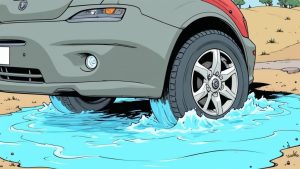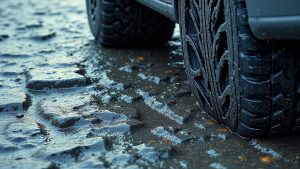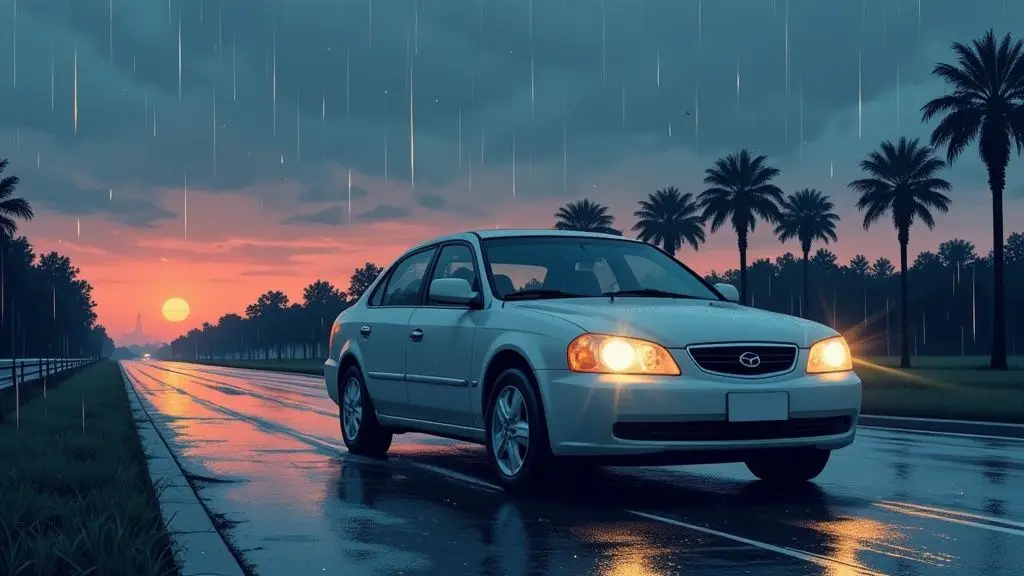Rainy weather turns simple drives into dangerous tasks. Wet roads make it harder for tires to grip. This means your car needs more space to stop. Also, heavy rain makes it hard to see other cars and road signs. Standing water can hide dangers like deep holes. For every driver, learning how to drive safely in the rain is a key skill. It is not just helpful; it is a must-do for safety.
This guide gives you important driving safety tips for rain. We will share useful tricks you can use right away. First, you will learn how to avoid hydroplaning. Next, we will cover how to manage your speed and following distance. Finally, we will make sure your car is ready for wet weather. Using these tips can lower your chance of a collision. This keeps you, your passengers, and others on the road safe. Let’s look at the best driving safety tips for rain.
1. Slow Down Your Speed
The most important driving safety tip for rain is to slow down. Wet roads are slippery, which means your car takes longer to stop. The U.S. Department of Transportation (USDOT) warns that wet pavement reduces tire traction. When you drive slower, you give yourself more time to react to surprises. For example, you can better handle a car stopping suddenly in front of you. This simple change can prevent a serious traffic incident.
According to the Federal Highway Administration (FHWA), nearly half of all weather-related crashes happen during rainfall. Slowing down by just 5 to 10 miles per hour can make a big difference. It helps you keep control of your car and stay safe when the roads are wet.
2. Increase Your Following Distance
Along with slowing down, you must also increase the space between you and the car ahead. In good weather, the three-second rule is a good guide. However, when it rains, you need more space. Safety experts suggest doubling this to six seconds. This extra room gives you the braking distance you need on slick roads.
To use the six-second rule, pick a fixed object like a road sign. When the car in front of you passes it, start counting. If you pass the same sign before you reach “six,” you are too close. The National Highway Traffic Safety Administration (NHTSA) often highlights safe following distances as a key part of defensive driving. More space means more time to stop safely.

3. Understand and Prevent Hydroplaning
Hydroplaning is a very dangerous situation. It happens when water between your tires and the road causes you to lose control. Your car might feel like it’s floating. This can happen at speeds as low as 35 mph. It is a critical driving safety tip for rain to know how to avoid this.

What to Do If You Hydroplane
If your car starts to hydroplane, it is important to stay calm. Follow these steps:
- Do not brake hard. This can cause your car to skid.
- Take your foot off the gas pedal. Let the car slow down on its own.
- Steer straight ahead. Keep a firm grip on the wheel and avoid sharp turns.
To prevent hydroplaning, drive slowly and avoid big puddles. Also, make sure your tires have good tread.
4. Check Your Tire Condition
Your tires are your car’s connection to the road. For this reason, their condition is vital for driving safely in the rain. Good tires help push water away so they can grip the road. A tire with low tread cannot do this well. This increases your risk of hydroplaning.

How to Check Your Tires
Checking your tires is easy. First, use a penny to check the tread depth. Place the penny with Lincoln’s head down into the tread. If you can see all of his head, your tires are too worn. Second, check the tire pressure every month. The correct pressure is on a sticker inside your driver’s side door. The NHTSA offers guides on tire safety that explain these steps in detail.
5. Turn On Your Headlights
When it rains, it is harder for other drivers to see you. One of the simplest driving safety tips for rain is to turn on your headlights. This makes your car much more visible. Even during the day, headlights help you stand out in the gray, rainy weather.
State Spotlight: California’s Headlight Law
Many states have laws about using headlights in the rain. In California, for example, the law is very clear.
According to the California Driver Handbook, you must turn on your headlights if you need to use your windshield wipers due to rain, fog, or snow. This is known as the “wipers on, lights on” rule.
Always use your low-beam headlights. High beams can reflect off the rain and make it harder for oncoming drivers to see.
6. Make Sure Your Wipers Work Well
Your windshield wipers are essential for seeing clearly in the rain. If they are old or worn, they will leave streaks on your windshield. This can block your view of the road. You should replace your wiper blades every six to twelve months.
Also, keep your windshield washer fluid full. Road spray from other cars can make your windshield dirty quickly. A good spray of washer fluid can clear it up right away. The Insurance Institute for Highway Safety (IIHS) notes that good driver visibility is a key factor in preventing collisions. Therefore, properly working wipers are a must-have.
7. Use Smooth and Gentle Controls
Driving on wet roads requires a soft touch. Sudden, sharp movements can make your tires lose their grip. This includes quick turns, hard braking, and fast acceleration. A key driving safety tip for rain is to be smooth with all your controls.
Imagine you are driving on ice. You would be very gentle with the steering wheel and pedals. You should do the same in the rain. Start braking earlier than usual and press the pedal lightly. Turn the steering wheel slowly and steadily. This helps keep the car stable and prevents skids.
8. Avoid Standing Water
You should never drive through large puddles or flooded roads. It is often impossible to know how deep the water is. It could be deep enough to stall your engine or even float your car away. The water might also hide big potholes or other damage to the road.
The National Weather Service has a famous saying: “Turn Around, Don’t Drown®”. This is a life-saving piece of advice. If you see a flooded road ahead, find another route. It is much safer to be late than to risk driving through dangerous water.
9. Know When to Stop Driving
Sometimes the rain is just too heavy to drive safely. If visibility is very poor or roads are flooding, the best choice is to pull over. This is one of the most important driving safety tips for rain. Find a safe place like a parking lot or rest area to wait for the storm to pass.
Do not stop on the shoulder of the highway if you can avoid it. Other drivers may have trouble seeing you. If you must stop on the shoulder, turn on your emergency flashers. The safest action is to get off the road completely until conditions improve.
10. Prepare an Emergency Kit
Being prepared for the unexpected is always a good idea. An emergency kit in your car can be very helpful if you get stuck in bad weather. Your kit should have items to keep you safe and comfortable while you wait for help.
The USDOT recommends that every car have an emergency kit. Here are some things to include:
- A flashlight with extra batteries
- A first-aid kit
- Jumper cables
- Reflective triangles or flares
- A rain poncho
- Bottled water and snacks
- A phone charger
11. Be Aware of Other Drivers
When driving in the rain, you must also pay close attention to other vehicles. Large trucks and buses can create a lot of spray, making it hard to see. Stay a safe distance behind them. Also, watch for drivers who are not adjusting their speed for the weather. Give them plenty of space.
Being a defensive driver means you are always aware of your surroundings. Anticipate what other drivers might do. For instance, someone might brake suddenly or change lanes without signaling. By staying alert, you can react safely to their actions. The Governors Highway Safety Association (GHSA) promotes defensive driving as a way to reduce traffic fatalities.
12. Use Your Defroster
Rainy weather often causes your car’s windows to fog up. This can severely limit your vision. Use your car’s defroster to keep the windows clear. The air conditioning system helps remove moisture from the air, which clears the fog faster.
Most cars have settings for both the front and rear windshields. Make sure you know how to use them before you start driving. A clear view out of every window is essential for safety. This simple step is an often overlooked but vital driving safety tip for rain.
Frequently Asked Questions (FAQ)
Q: What is the most important driving safety tip for rain?
A: The most important tip is to slow down and increase your following distance. Wet roads reduce traction, so you need more time and space to stop safely. This simple adjustment greatly reduces your risk of a collision.
Q: How much should I slow down in the rain?
A: A good rule is to reduce your speed by at least 5 to 10 mph below the posted speed limit. In very heavy rain or with low visibility, you should slow down even more. Always drive at a speed that feels safe for the conditions.
Q: What should I do if my car starts to hydroplane?
A: If you hydroplane, stay calm. Take your foot off the accelerator and do not slam on the brakes. Steer straight until your tires regain their grip on the road.
Q: Why do I need to turn on my headlights in the rain?
A: Turning on your headlights makes your vehicle more visible to other drivers. Rain, spray, and gray skies can make it hard to see other cars. Many states, including California, have laws that require your headlights to be on when your wipers are in use.
Q: Is it safe to use cruise control in the rain?
A: No, you should never use cruise control when driving in the rain. If your car hydroplanes, cruise control can cause the wheels to spin faster, making it harder to regain control. You need to be in full control of your speed at all times on wet roads.
Always Put Safety First
Driving in the rain requires your full attention. By following these driving safety tips for rain, you can handle wet roads with more confidence. Remember to always adjust your driving to the weather conditions. Your main goal is to arrive at your destination safely.
Being a safe driver is a skill that you can always improve. Slowing down, keeping a safe distance, and ensuring your car is in good condition are the foundations of wet-weather safety. These habits protect not only you but everyone else who shares the road. Drive smart, and stay safe.
Ready to sharpen your defensive driving skills and potentially reduce your insurance premiums? Enrolling in a driver improvement course is an excellent next step to reinforce the lessons learned here. Our online courses are designed to make you a safer, more confident driver in any weather. Learn more and register today at https://bdischool.com/courses.





